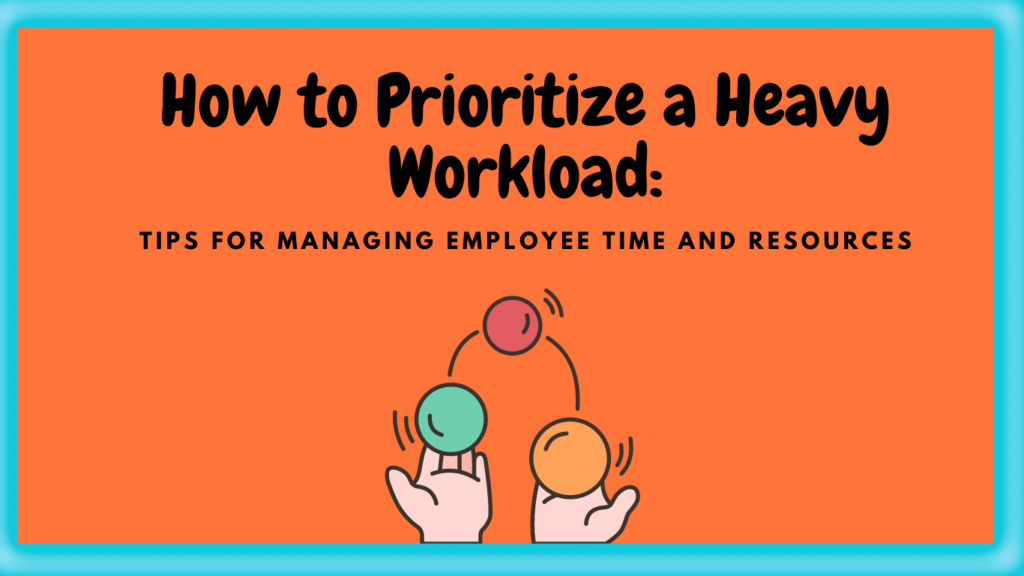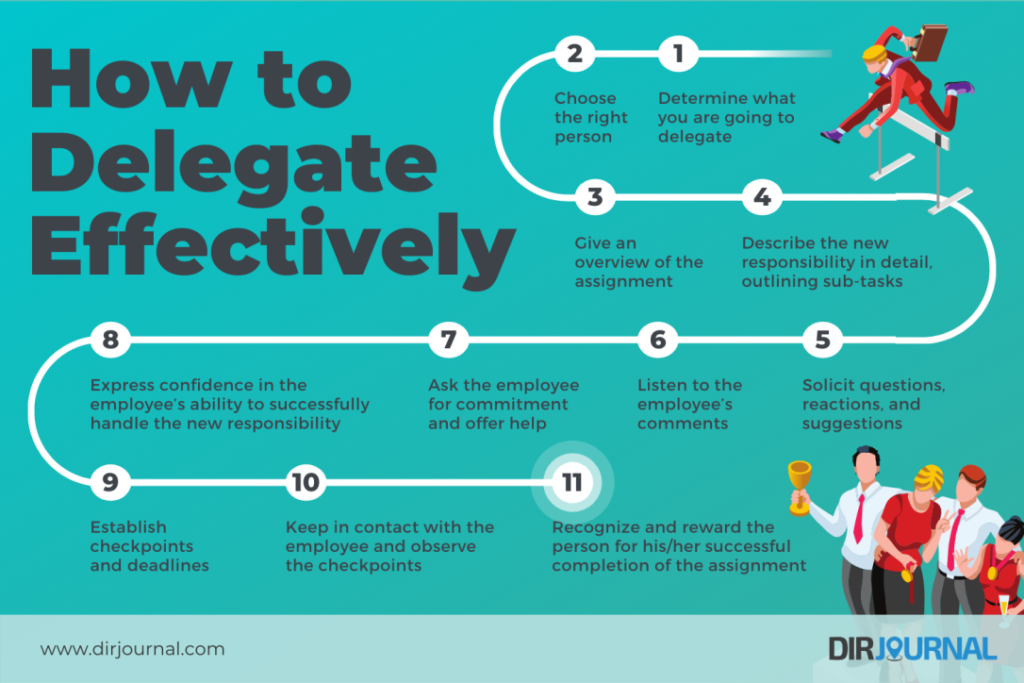How to Manage Employee Workload

How can you manage employees and their work time when there is a need to handle a heavy workload? This is a question that many business owners struggle with. It can be difficult to know how to work around the management of employee workload, and how to best prioritize and organize tasks in a way that makes the most sense for everyone.
In this blog post, we will discuss some tips for employee management, time, and resources. By following these tips, you can ensure that everyone on your team is productive and efficient!
Keep reading!

We all can agree on the importance of having motivated employees in your company. After all, what is your company without its most valuable asset which is its workforce?
Productivity and efficiency are important factors in any business, but they can be difficult to achieve when employees are bogged down by a heavy workload.
When there is too much work and not enough time to complete it, employees can become stressed and overwhelmed. This can lead to high employee turnover rates, low morale, and employee engagement, as well as poor employee performance.
In fact, according to Zippia, the first cause of stress at work is… Guess what? Workload.

Still today, the company culture of “more is best” prevails causing a questionable employee management process, in which the human capital is not given the importance they deserve.
This “more is best” mentality often leads to managers giving their employees more work than they can handle, in the hopes that it will motivate them to work harder and deliver maximum efficiency. And, we hope you are not the case!
However, if you unconsciously have made this mistake, it is not something to worry about since it can be fixed with effective employee management and performance management in place!
What Is Effective Employee Management?
Effective employee management is the process of “ensuring that employees can work to their fullest potential, completing all the assigned tasks, without becoming overwhelmed by their workload.”
It involves creating a balance between employee productivity and their well-being so that they can stay motivated and engaged in their work.
When done correctly, effective employee management will lead to a more productive and efficient workforce
A few key elements of effective employee management are:
- Trust and transparency between managers and employees
- A clear understanding of roles and responsibilities
- The ability to delegate work effectively
- Proper communication channels
- Regular feedback and performance reviews
Can you confirm these elements are present in your employee management system? If not, don’t worry. We are helping you through it!
Are you ready to manage the workload of your employees effectively? Keep reading!
Tips for Employee Workload Management, Time, and Resources
As an effective manager, it is your responsibility to ensure that your employees have the time and resources they need to complete their work without becoming overwhelmed.
Here are a few tips that can help you manage employee time and resources effectively:
We Don’t Multitask or Micromanage Here!
The first step to managing employee time and resources effectively is to avoid multitasking and micromanaging. Forget the “more is best” and keep yourself focused on “work smarter.”
When you try to do too many things at once, you end up doing all of them poorly. The same goes for when you try to micromanage your employees
When you look at the stats below, there is one that looks alarmingly serious: “More than 31 workweeks lost each year due to switching tasks.” Do you realize this translates into around 7 months? That your employees are not being productive for 7 months?

If you micro-manage, you will only end up bogging them down with more work, resulting in poor performance, all while preventing your employees from developing their own pace and rhythm.
Instead of multitasking or micromanaging, focus on one task at a time and delegate tasks to your employees.
This will help you stay organized and focused, while also giving your employees the freedom to work independently.
Understand Your Employees’ Workloads
Now, it’s the turn of managing employees’ workloads! This means understanding what your employees are working on and knowing if all team members are on the same page.
As well as being aware of the projects they are working on, the tasks they are responsible for, and the deadlines they are facing.
There are a lot of benefits of understanding and managing employees’ workloads since you can:
- Identify when an employee is overloaded and help them to prioritize their work
- Prevent overlap in work and duplication of effort
- You will be able to see which projects are behind schedule and take corrective action
- Better allocate resources based on where they are needed
- Then take steps to address these issues and help them get back on track.
Prioritize Tasks and Set Deadlines
The next step of employee management is to prioritize tasks and set deadlines. This will help you ensure that all tasks are given the appropriate level of attention and that employees are working on the most important tasks first.
You can apply a task prioritization technique, such as the Ivy Lee method. This method consists of:
- At the end of each workday, write down the six most important tasks that you need to complete tomorrow.
- Then, rank them in order of importance.
- Once you have ranked the tasks, start working on the first task on the list and continue until it is finished before moving on to the next task.
- If you cannot finish all six tasks in one day, don’t worry! Just move any unfinished tasks to the top of your list for the next day.

Making sure that all tasks are given the appropriate level of attention and that employees are working on the most important tasks first will help you get the most out of your team.
Set Up a Timeline
As well, one of the most important steps in managing employee time and resources is to have a timeline. This will help ensure that all work is completed on time and that deadlines are met.
A timeline can also help you identify when an employee is overloaded and needs assistance.
If an employee is behind schedule, you can take corrective action to get everything back on track!
When creating a timeline, be sure to:
- Include all tasks that need to be completed
- Include deadlines for each task
- Make sure the timeline is realistic
- Be sure to communicate the timeline to all team fellows
Having a timeline will help you stay organized and focused, while also ensuring that all team fellows are aware of upcoming deadlines.
Get Constant Feedback From Your Employees
Learn to effectively get feedback from your employees! This will help you understand how they are feeling about their workloads and if they are struggling with anything along the road.
Ongoing feedback also allows for managers to make changes in real-time, rather than waiting for a scheduled performance review
When getting feedback from your employees, be sure to:
- Create an open and safe environment where employees feel comfortable giving honest feedback.
- Engaging employees in workload management debunkers poor performance allowing employees to establish healthy relationships within the company.
- Encourage employees to give both positive and negative feedback
- Allow employees to provide anonymous feedback if they prefer. Nevertheless, keep employee recognition aways in mind
- Be open to all suggestions and take them into consideration

Getting constant feedback from your employees will help you manage their workloads more effectively.
Invest in an Employee Management Software
However, it can be difficult to keep track of all the different projects your employees are working on and how they are progressing. This is where employee management software can be a valuable tool.
Employee Management Software (EMS) is a system designed to help businesses manage employee workloads. The software allows businesses to track employee hours, productivity levels, and vacation time
Employee management software will allow you to:
- Track the progress of all your employees’ projects in one place
- Communicate with your team fellows easily
- Get real-time reports on how your team is performing

EMS is a valuable tool for any business that wants to manage its workforce effectively. Employee management software can help you keep track of employee hours and run performance management.
Delegate Work Appropriately
Ah, the fine art of delegation!
Delegation is the process of assigning responsibility for a task or project to another individual. Delegation allows leaders and senior management to distribute their workload and ensure that tasks are completed effectively.
Assigning tasks to the right employees is essential for delegation to be successful
When choosing who to delegate a task to, consider:
- The skills and knowledge required to complete the task
- The availability of the employee
- The workload of the employee
However, remember that delegation must be supported by competent coaching! Assigning a task is not enough – you must also provide guidance on how to complete the task and be available to answer any questions.
Delegating work appropriately is an essential skill for any manager
When done correctly, delegation can help reduce your workload and improve team productivity. If you are not sure how to start effective delegation, below there is a road map for you!

Effective Communication
Managers should keep employees informed about changes that might affect their workloads, such as new initiatives or deadlines.
They should also provide regular feedback about how individuals are performing and let employees know when they are meeting expectations or need to improve.
Employees, on the other hand, need to be proactive in communicating with their managers about their workloads
If they feel like they are taking on too much work, they should speak up so that their manager can help redistribute some of the tasks.

Run Performance Reviews
Conducting performance reviews are a valuable opportunity for managers to assess their employees’ work and give feedback. As well, they help identify any areas where employees need additional training or support.
Reviews should be conducted regularly – at least once a year – to ensure that employees are meeting expectations

Running performance assessments is an important way for managers to assess workloads and give feedback to employees. Doing so can help identify any areas where employees need additional training or support.
Be Flexible
Yes, reviews should be conducted regularly to ensure that employees are meeting expectations, but remember to be flexible. If an employee is struggling with their workload, try giving them more assistance or training.
For example, if an employee is struggling to meet deadlines because they have young children at home, you could offer them flexible working hours.
Flexible working arrangements are not possible in all cases, but if they are an option, they can be a valuable tool for managing employee workloads
Being flexible with your employees’ workloads shows that you understand and respect their individual needs. It can also help to reduce stress levels.

On the other hand, if an employee is excelling, consider giving them more responsibility. The key is to find a balance that works for both you and your team!
Assess the Situation before Making a Decision
When you are considering how to manage employee workload, it is important to assess the situation before making a decision. You should consider:
- the skills and knowledge required to complete the task,
- the availability of the employee, and
- the workload of the employee.
When you are managing a team, it is important to take the time to assess a situation before making a decision
Consider all of the factors involved and consult with your team members to get their input. Only then will you be able to make an informed decision that is in the best interest of both you and your team!

Realign Priorities Regularly
Realigning priorities on a regular basis is crucial for managing employee workload. By taking some time each week or month to evaluate what tasks are most important, you can ensure that your employees are always working on the most pressing issues.
Realigning priorities can be a simple process, but it can make a big difference in how efficiently your team works.
This also allows you to identify any areas where employees may be struggling and adjust their workload accordingly.
Final Thoughts
Prioritizing a heavy workload can be a challenge for any manager. However, by following the tips that offer content employee management, you can manage your team’s time and resources effectively.
And remember – communication is key! Keep your employees informed about changes in workloads and give regular feedback to ensure that everyone is on the same track. With a little planning and effort, you can successfully prioritize your team’s workload!
Below, you can find a little DO and DON’T of managing the workload of employees effectively, if you feel a little lost, you can always come back and read it!

Thanks for reading! We hope this article was helpful.
-The Monitask Team


